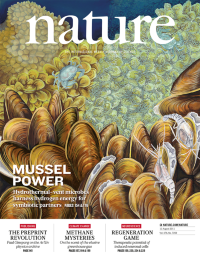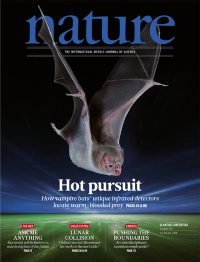Volume 476
-
No. 7361 25 August 2011
Historians and scientists have long theorized that the global climate and global patterns of violence might be connected, but this idea has never been directly tested with data. Now a new analysis examines whether civil conflicts might be linked to the El Niño-Southern Oscillation (ENSO), the dominant mode of interannual variability in the modern global climate. Using data on tropical countries collected between 1950 and 2004, the study finds that the probability of new civil conflicts breaking out in El Niño years is double that seen in cooler La Niña years. Overall, these findings suggest that the ENSO may have played a part in initiating 21% of all civil conflicts since 1950. This study represents the first demonstration that the stability of modern societies is associated with the global climate. The cover image shows the number of months per year, with blue equal to zero and red equal to twelve, that surface temperatures warm in response to El Niño. The warming of the tropics is caused by an atmospheric Kelvin wave generated in the Pacific Ocean and trapped near the Equator by Earths rotation. Cover image: Solomon M. Hsiang.
-
No. 7360 18 August 2011
When a drop of coffee dries, a halo of particles accumulates at the drops edge. This coffee-ring effect, first described formally in a Nature paper in 1997, is a common occurrence when a solution of suspended colloidal particles evaporates. Far from being just a household curiosity, it has turned out to have relevance for many applications in which a uniform particle deposition is required, such as inkjet printing, assembly of photonics components and manufacture of DNA chips. In this issue, Peter Yunker and colleagues show that ellipsoidal particles suppress the coffee-ring effect. Attractive interparticle interactions between ellipsoids are sufficiently strong to counteract the forces that drive spherical particles towards the drop's edge as the drop evaporates. The coffee-ring effect can be restored for ellipsoids in solution containing surfactant, and designed mixtures of spheres and ellipsoids can lead to uniform deposition. Cover photo: Annthea Lewis.
-
No. 7359 11 August 2011
All life at deep-sea hydrothermal vents relies on the geofuels provided by hot fluids spewing from the sea floor. Only two of these fuels were known to provide energy for chemosynthetic symbionts - reduced sulphur compounds, used by sulphur-oxidizing symbionts, and methane, used by methane-oxidizing symbionts. Now hydrogen can be added to that list. Bathymodiolus mussels from hydrothermal vents on the Mid-Atlantic Ridge have been found to associate with microbial symbionts that can use hydrogen for primary production. A key gene for the oxidation of hydrogen is present in the symbionts of other hydrothermal vent animals such as the tubeworm Riftia pachyptila and the shrimp Rimicaris exoculata, suggesting that hydrogen may be an important energy source in other symbioses as well. Cover illustration: Abigail Lingford.
-
No. 7358 4 August 2011
A common vampire bat (Desmodus rotundus) in flight, photographed in Mexico. These blood-feeding bats have evolved the ability to detect infrared (IR) radiation as a means of locating hot spots on warm-blooded prey. Only three other vertebrate lineages have this 'sixth' sense: three distantly related groups of snakes (pit vipers, pythons and boas). In all cases, the IR sensor is a highly specialized facial structure called the pit organ. In the snakes, a non-heat-sensitive ion channel (vertebrate TRPA1) has become an infrared detector. As reported in this issue, vampire bats use a slightly different molecular mechanism whereby RNA splicing generates a variant of the ubiquitous TRPV1 heat-sensitive channel that is tuned to lower temperatures. Comparison of this channel's gene sequence with the equivalent in other mammals lends support to the hypothesis based on molecular data that these bats are evolutionarily grouped with horses, dogs, cows, moles and dolphins (in the Laurasiatheria superorder), rather than with humans, monkeys and rodents (in the Euarchontoglires) as originally proposed on anatomical criteria. Cover: Barry Mansell/naturepl.com




